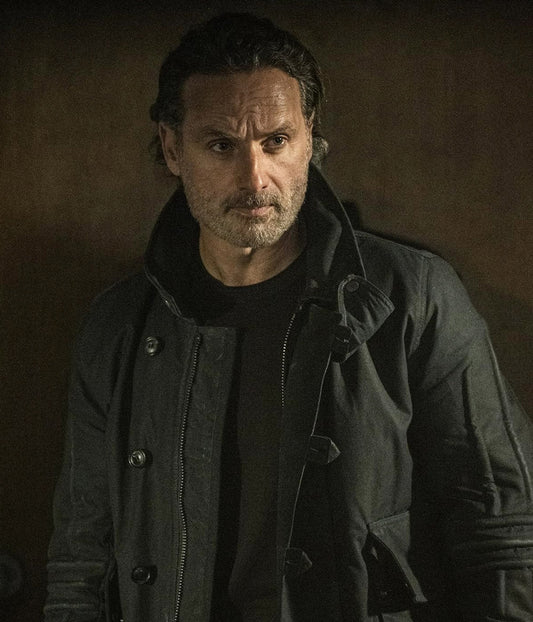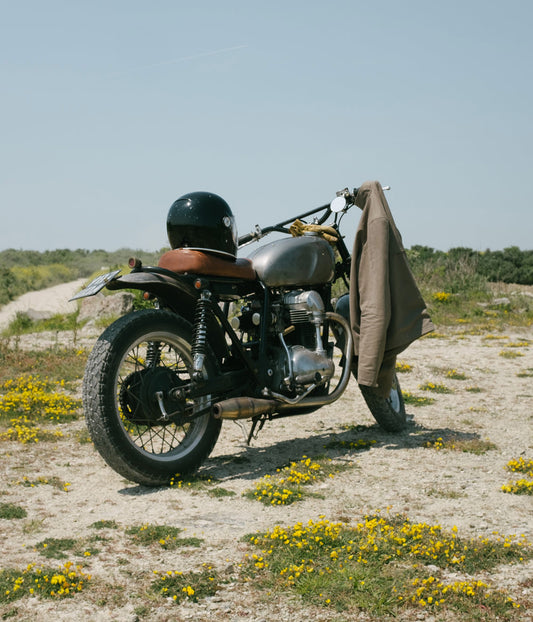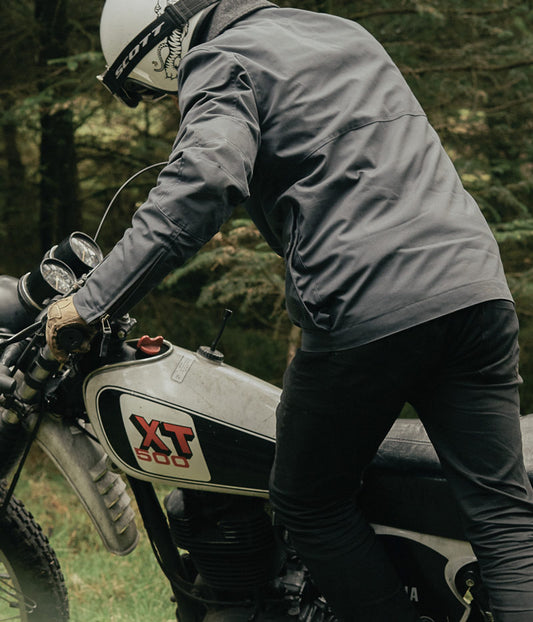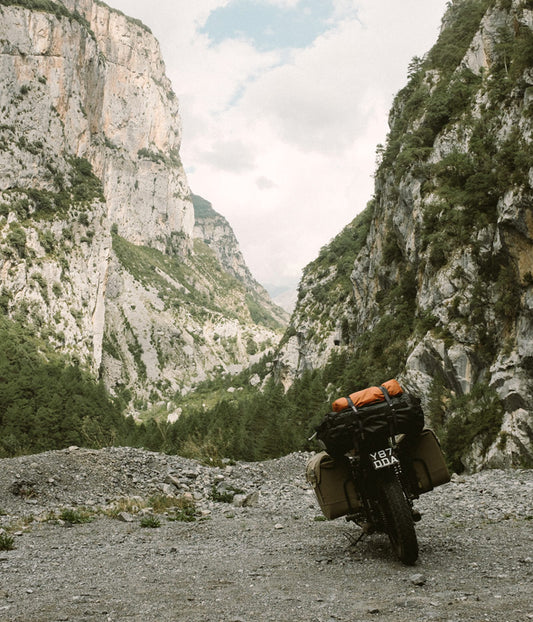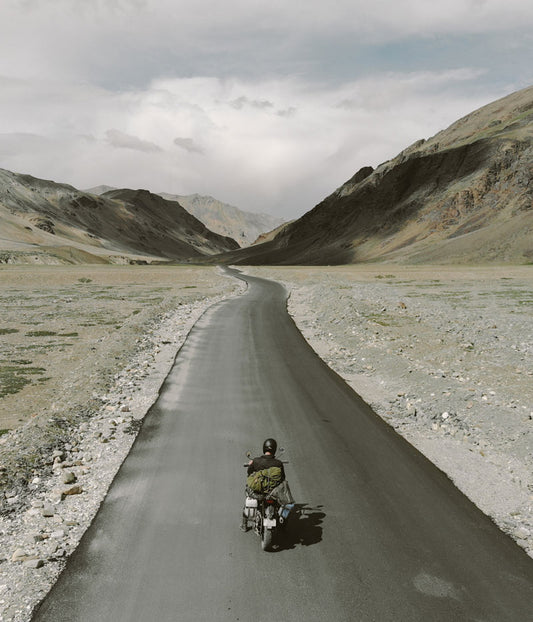Isle Of Harris
The ferry’s engine beat a path through thirty miles of deep turquoise water towards the Isle of Harris. On deck, the sun warmed through a stiff sea breeze. First onto the boat, I was first off. Leaving the port at Tarbert, the two wheels of my Kawasaki W650 followed a ribbon of tarmac that draped itself over the shoulders of Clisham - the highest peak in the Outer Hebrides. Mountains drew themselves up around me - the opening act to a two-wheeled dance I’d do all the way up to Carloway Mill - one of the island’s main producers of Harris Tweed.
This was a last-minute trip. Having not had time to do any research, I didn’t know what to expect. As I crossed over into Lewis I was glad. The stacked contours of the south were ironed smooth, a horizon of unbroken scrub stretched across the horizon. Over half of the island's population live in Stornoway - its biggest city. The draw of this magnet creates a sense of space across the rest of the island like I’d not experienced before in the UK. I could have been riding the great plains. I stopped, made wrong turns. Forty miles took an hour and a half. Having time will always be the greatest luxury.
“FIRST ONTO THE BOAT, I WAS FIRST OFF. LEAVING THE PORT AT TARBERT, THE TWO WHEELS OF MY KAWASAKI W650 FOLLOWED A RIBBON OF TARMAC THAT DRAPED ITSELF OVER THE SHOULDERS OF CLISHAM - THE HIGHEST PEAK IN THE OUTER HEBRIDES.”
From this unassuming island tucked off the coast of Scotland comes one of the world’s most respected fabrics. Like a pre-war Brough, Harris Tweed has an aura, a presence. In the clothing industry, a David amongst Goliaths. From spinning to weaving, every stage of fabric production takes place on Harris and Lewis. The fabric’s legacy is protected under law by the 1993 Harris Tweed Act of Parliament. To carry the prestigious name, Harris Tweed must be made from pure virgin wool that’s been dyed, spun, and handwoven by the Islanders in their homes on the Outer Hebrides.
I arrived at the mill, turned the engine off and out from behind a storeroom strolled Willie (pronounced Wolly), one of Carloway’s technicians. Hands in pockets, we talked about my bike. He mentioned that he had a few himself, ‘thirty-five’, stored in two containers at the end of his garden. We swapped stories and he shared his local knowledge, marking my map with the waypoints of a route he and his friends call ‘the circuit’. As he left to go back to work, he gave me his number in case I had any problems. I learnt afresh how generous the motorcycling community is.
Having worked for a decade as a clothing designer, I’ve been to a number of spinners and weavers over the years. I’m familiar with the way it works. What set Carloway apart from other mills I’ve visited was its machinery. It was some of the oldest I’d seen in use; the earliest dating back to 1892, the newest had been at work for fifty years. I always have a lot of respect for companies that keep old machinery working. If I see someone taking care of their tools, I know they’ll take pride in what they’re producing. It’s a good sign.
Harris Tweed is famous for its use of colour. Rather than weaving one shade, a palette of dyed wool is combined in different formulas to build an impression. The result is a cloth littered with vibrant sparks. In the past, I’d only ever seen the finished tweed. Seeing the wool mixed, carded and spun was magic. Across the pages of their decade-old archive, I saw colour from the landscapes that I had just ridden through. It made me think, all too often I look for inspiration from far-flung places. It takes a certain skill to draw inspiration from what hides under your nose. Something for me to work on.
Before parting ways I spoke to Annie, the manager of Carloway, about her corner of the industry; listening to the challenges she’s facing, the areas that are going. These conversations have taught me a lot and for me, this is what it’s about. Good design it’s not about having an egotistical vision, a mantra that an industry must follow. Good design is about working as part of a chain. It starts with the farmer and links manufacture, retail, right the through to the person who uses the garment. If one link breaks everyone is affected.
“GOOD DESIGN IS ABOUT WORKING AS PART OF A CHAIN. IT STARTS WITH THE FARMER AND LINKS MANUFACTURE, RETAIL, RIGHT THE THROUGH TO THE PERSON WHO USES THE GARMENT. IF ONE LINK BREAKS EVERYONE IS AFFECTED.”
I woke early. My return ferry was in the late afternoon, this gave me more than enough time to explore the Bays of Harris - a series of inlets running down the South-West coast. A few nights before, a friend had recommended Mission House, a church that's been converted into a gallery space. This is where I was headed.
The landscape transformed once more. Crests of granite showed themselves through a rolling sea of grass. A scattering of houses punctured this motif - the single-lane track I followed threading from one to the next. As I went, I could pick out the colours I’d seen woven through the tweed a day before. Again, I took my time. Took lots of pictures. An hour later I found Mission House.
As was the way at the mill, so it was here. On hearing the engine Nikolai came out to meet me. I could tell instantly that we were like-minds. We spoke about my bike, where I’d been, where I was going. Disguising a grin, he said ‘you should take a look in there’. Inside the gallery, nestled in amongst his ceramic sculptures was a gleaming BMW r80RT. His love of the forms that make up this motorcycle was such that he’d bought it having not yet fully passed his test.
Nikolai’s work takes inspiration in the objects and textures around him. His sculpture looks to expose the internal structure of a material. I like this approach and could see a connection with the honest mechanical forms of his bike. He showed me his studio at the back of the gallery, shelves stacked high with ideas. On every surface, a different thought. I could have stayed for the afternoon. In fact, I could have stayed for longer. He’d got the balance just right.
Unscrewing the fuel cap, I could see I’d ridden further than I thought. We said our goodbyes and I followed directions to the nearest petrol station. I continued around the Southern tip of the island and picked up a fast road back towards Tarbert. It was time to head back over to Skye and home. The tail of the ferry lowered - a final curtain on what had been the best kind of trip, the kind where experience far outweighs time.
---
WORDS + PHOTOGRAPHS: ASHLEY WATSON













